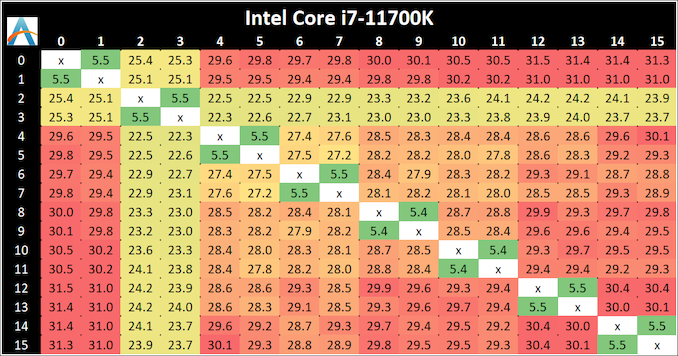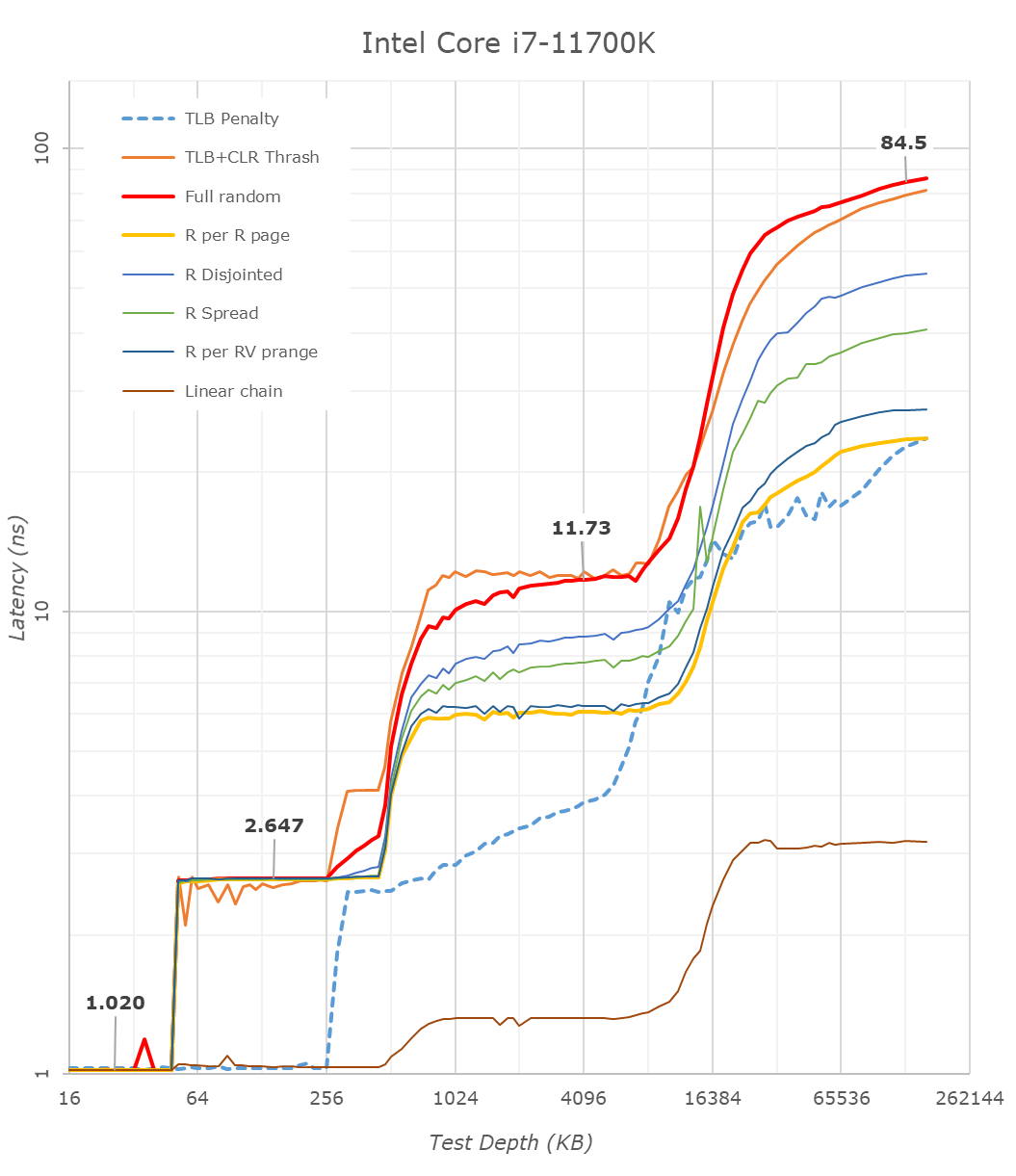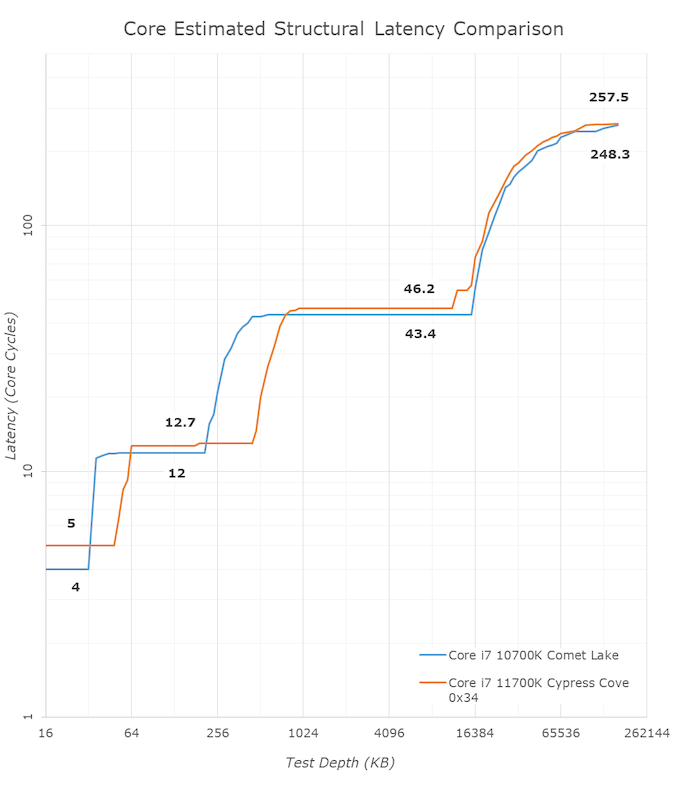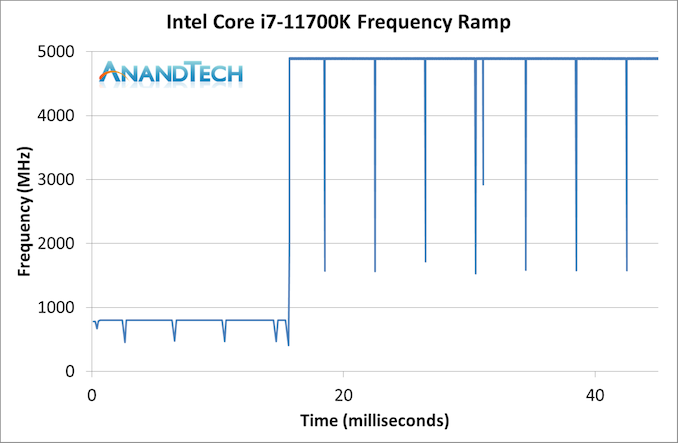Intel Core i7-11700K Review: Blasting Off with Rocket Lake
by Dr. Ian Cutress on March 5, 2021 4:30 PM EST- Posted in
- CPUs
- Intel
- 14nm
- Xe-LP
- Rocket Lake
- Cypress Cove
- i7-11700K
CPU Tests: Microbenchmarks
Core-to-Core Latency
As the core count of modern CPUs is growing, we are reaching a time when the time to access each core from a different core is no longer a constant. Even before the advent of heterogeneous SoC designs, processors built on large rings or meshes can have different latencies to access the nearest core compared to the furthest core. This rings true especially in multi-socket server environments.
But modern CPUs, even desktop and consumer CPUs, can have variable access latency to get to another core. For example, in the first generation Threadripper CPUs, we had four chips on the package, each with 8 threads, and each with a different core-to-core latency depending on if it was on-die or off-die. This gets more complex with products like Lakefield, which has two different communication buses depending on which core is talking to which.
If you are a regular reader of AnandTech’s CPU reviews, you will recognize our Core-to-Core latency test. It’s a great way to show exactly how groups of cores are laid out on the silicon. This is a custom in-house test built by Andrei, and we know there are competing tests out there, but we feel ours is the most accurate to how quick an access between two cores can happen.
The core-to-core numbers are interesting, being worse (higher) than the previous generation across the board. Here we are seeing, mostly, 28-30 nanoseconds, compared to 18-24 nanoseconds with the 10700K. This is part of the L3 latency regression, as shown in our next tests.
One pair of threads here are very fast to access all cores, some 5 ns faster than any others, which again makes the layout more puzzling.
Update 1: With microcode 0x34, we saw no update to the core-to-core latencies.
Cache-to-DRAM Latency
This is another in-house test built by Andrei, which showcases the access latency at all the points in the cache hierarchy for a single core. We start at 2 KiB, and probe the latency all the way through to 256 MB, which for most CPUs sits inside the DRAM (before you start saying 64-core TR has 256 MB of L3, it’s only 16 MB per core, so at 20 MB you are in DRAM).
Part of this test helps us understand the range of latencies for accessing a given level of cache, but also the transition between the cache levels gives insight into how different parts of the cache microarchitecture work, such as TLBs. As CPU microarchitects look at interesting and novel ways to design caches upon caches inside caches, this basic test proves to be very valuable.
Looking at the rough graph of the 11700K and the general boundaries of the cache hierarchies, we again see the changes of the microarchitecture that had first debuted in Intel’s Sunny Cove cores, such as the move from an L1D cache from 32KB to 48KB, as well as the doubling of the L2 cache from 256KB to 512KB.
The L3 cache on these parts look to be unchanged from a capacity perspective, featuring the same 16MB which is shared amongst the 8 cores of the chip.
On the DRAM side of things, we’re not seeing much change, albeit there is a small 2.1ns generational regression at the full random 128MB measurement point. We’re using identical RAM sticks at the same timings between the measurements here.
It’s to be noted that these slight regressions are also found across the cache hierarchies, with the new CPU, although it’s clocked slightly higher here, shows worse absolute latency than its predecessor, it’s also to be noted that AMD’s newest Zen3 based designs showcase also lower latency across the board.
With the new graph of the Core i7-11700K with microcode 0x34, the same cache structures are observed, however we are seeing better performance with L3.
The L1 cache structure is the same, and the L2 is of a similar latency. In our previous test, the L3 latency was 50.9 cycles, but with the new microcode is now at 45.1 cycles, and is now more in line with the L3 cache on Comet Lake.
Out at DRAM, our 128 MB point reduced from 82.4 nanoseconds to 72.8 nanoseconds, which is a 12% reduction, but not the +40% reduction that other media outlets are reporting as we feel our tools are more accurate. Similarly, for DRAM bandwidth, we are seeing a +12% memory bandwidth increase between 0x2C and 0x34, not the +50% bandwidth others are claiming. (BIOS 0x1B however, was significantly lower than this, resulting in a +50% bandwidth increase from 0x1B to 0x34.)
In the previous edition of our article, we questioned the previous L3 cycle being a larger than estimated regression. With the updated microcode, the smaller difference is still a regression, but more in line with our expectations. We are waiting to hear back from Intel what differences in the microcode encouraged this change.
Frequency Ramping
Both AMD and Intel over the past few years have introduced features to their processors that speed up the time from when a CPU moves from idle into a high powered state. The effect of this means that users can get peak performance quicker, but the biggest knock-on effect for this is with battery life in mobile devices, especially if a system can turbo up quick and turbo down quick, ensuring that it stays in the lowest and most efficient power state for as long as possible.
Intel’s technology is called SpeedShift, although SpeedShift was not enabled until Skylake.
One of the issues though with this technology is that sometimes the adjustments in frequency can be so fast, software cannot detect them. If the frequency is changing on the order of microseconds, but your software is only probing frequency in milliseconds (or seconds), then quick changes will be missed. Not only that, as an observer probing the frequency, you could be affecting the actual turbo performance. When the CPU is changing frequency, it essentially has to pause all compute while it aligns the frequency rate of the whole core.
We wrote an extensive review analysis piece on this, called ‘Reaching for Turbo: Aligning Perception with AMD’s Frequency Metrics’, due to an issue where users were not observing the peak turbo speeds for AMD’s processors.
We got around the issue by making the frequency probing the workload causing the turbo. The software is able to detect frequency adjustments on a microsecond scale, so we can see how well a system can get to those boost frequencies. Our Frequency Ramp tool has already been in use in a number of reviews.
Our ramp test shows a jump straight from 800 MHz up to 4900 MHz in around 17 milliseconds, or a frame at 60 Hz.














541 Comments
View All Comments
Hifihedgehog - Friday, March 12, 2021 - link
LOL. Fanboy delusion.First off, let's take a quick looksie at the Cinebench R20 results:
https://www.hardwareluxx.de/index.php/artikel/hard...
When switching from BIOS version 0402 to 0603, the 11700K's single-threaded performance actually DROPS from a score of 609 to 600. And its multicore performance is still less than the 10900K and the 5800X.
Switching gears, the games are no less unflattering:
https://www.hardwareluxx.de/index.php/artikel/hard...
The 11700K there, regardless of which of the two BIOS releases it uses, often loses to the 10900K and Ryzen 5000 series. It loses to the Ryzen 5000 series and 10900K in THREE out of the four games: The Division 2, Metro Exodus, The Shadow of the Tomb Raider.
In short: dude, what are you smoking?
Technobile - Friday, March 12, 2021 - link
The 10700K costs a pittance at the minute, and after the final bios and microcode 11700K will be around 15 to 20% faster than it. Both a bargain when the only other option is dealing with the 'quirks' (to be kind) of an AMD systemQasar - Friday, March 12, 2021 - link
" The 10700K costs a pittance at the minute, and after the final bios and microcode 11700K will be around 15 to 20% faster than it " i will believe that, when i see it, honestly, that is hopeful thinking." Both a bargain when the only other option is dealing with the 'quirks' (to be kind) of an AMD system " and intel has had its own quirks over the years.
dsplover - Saturday, March 13, 2021 - link
They’re just doing this to give the impression they’re relevant. It’s safe to assume they’ll retake some market share but AMD took servers, laptop and desktop sectors by storm while Intel keeps moving old designs out the door.AMD 5750G, if it exists will render Intel designs useless this summer, while Intel struggles to get Alder Lake up and running.
Motherboard manufacturers will get tired of chasing new sockets after AM5 comes out.
What happened to these guys? It’s embarrassing and I’m an i7 fan boy..
GeoffreyA - Saturday, March 13, 2021 - link
"What happened to these guys?"My guess would be: complacency, underestimating the enemy, putting eggs in too many dead-end baskets, and management that made a mess of excellent engineering talent.
CiccioB - Sunday, March 14, 2021 - link
When reading this I think some of you just ended their school yesterday (with poor results) and just came here to say the first thing they think it is pro AMD. Just to give a (poor) contribution to what they think is an easy (for everyone) task as beating a dead horse (Intel).
I may shock you if I say that that "chasing designs" effort is the secret trick for motherboard producer too... surprise surprise.. MAKE MONEY!
So they do not get tired to do anything if this means selling more motherboards, and this just happens if you have to change your motherboards every couple of generations.
And I may shock you even more if I say you that those that make an upgrade using the same motherboard is just a so small number that no motherboard producer is really interested in supporting.
Usually when you change your CPU you just do not want only it to go a little faster but you want also the new technological improvements that meantime have been created, from faster bus, new and more connectors (M2 vs SATA), faster USBs, Thunderbolts, better memory support and such.
And this doesn't come if you do not also change the motherboard.
And to have and propose a better motherboard to sell, guess what? Yes, motherboard producer have to play the "chasing designs" game.
rfxcasey - Thursday, March 18, 2021 - link
Yeah "useless", please, all of this is splitting hairs, none of these processors are even close to being "useless".rfxcasey - Wednesday, March 17, 2021 - link
To me, looks like the i7 10700k holds it's own against the 5800x in gaming performance and is much cheaper.rfxcasey - Thursday, March 18, 2021 - link
i7 10700K actually beating the 5800x in many game benchmarks. I don't have a preference between AMD and Intel generally, but the i7 10700K is a great gaming processor, Intel did seem to make an embarrassing move with the 11th Gen, but for the cost, the 10700k a top, possibly THE top gaming CPU.quadibloc - Thursday, March 18, 2021 - link
When an official review comes in, with all the details, things may look a little better. But even now, I see one thing that's being overlooked. Since these chips have AVX-512, where that can be used, that will double their performance compared to processors that only have AVX-256. Except, of course, for the necessary slowdown for thermal reasons. So on workloads that involve a lot of AVX-512, they should really shine instead of being as terribly lackluster as they appear when that isn't taken into account.